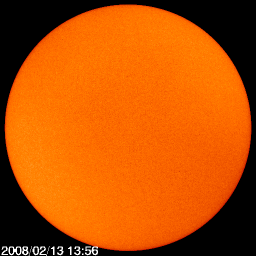
|
| ©NASA |
The sun has gone quiet. Really quiet.
It is normal for our sun to have quiet periods between solar cycles, but we've seen months and months of next to nothing, and the start of Solar cycle 24 seems to have materialized (as first reported here) then abruptly disappeared. The reverse polarity sunspot that signaled the start of cycle 24 on January 4th, dissolved within two days after that.
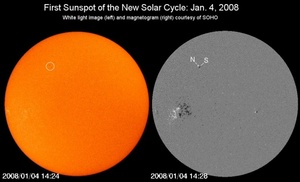
|
| ©NASA |
Of course we've known that the sunspot cycle has gone low, which is also to be expected for this period of the cycle. Note that NOAA still has two undecided scenarios for cycle 24 Lower that normal, or higher than normal, as indicated on the graph below:
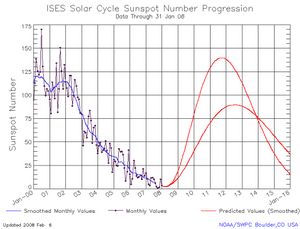
|
| ©NOAA/SWPC |
But the real news is just how quiet the suns magnetic field has been in the past couple of years. From the data provided by NOAA's Space Weather Prediction Center (SWPC) you can see just how little magnetic field activity there has been. I've graphed it below:
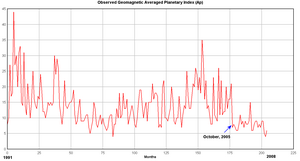
|
| ©NOAA |
What is most interesting about the Geomagnetic Average Planetary Index graph above is what happened around October 2005. Notice the sharp drop in the magnetic index and the continuance at low levels.
This looks much like a "step function" that I see on GISS surface temperature graphs when a station has been relocated to a cooler measurement environment. In the case of the sun, it appears this indicates that something abruptly "switched off" in the inner workings of the solar dynamo. Note that in the prior months, the magnetic index was ramping up a bit with more activity, then it simply dropped and stayed mostly flat.
We saw a single reversed polarity high latitude sunspot on January 4th, 2008, which would signal the start of a new cycle 24, which was originally predicted to have started last March and expected to peak in 2012. So far the sun doesn't seem to have restarted its normal upwards climb.
If you have ever studied how the magnetic dynamo of the sun is so incredibly full of entropy, yet has cycles, you'll understand how it can change states. The sun's magnetic field is a like a series of twisted and looped rubber bands, mostly because the sun is a fluid gas, which rotates at different rates between the poles and the equator. Since the suns magnetic field is pulled along with the gas, all these twists, bumps, and burps occur in the process as the magnetic field lines get twisted like taffy. You can see more about it in the Babcock model.
I've alway's likened a sunspot to what happens with a rubber band on a toy balsa wood plane. You keep twisting the propeller beyond the normal tightness to get that extra second of thrust and you see the rubber ban start to pop out knots. Those knots are like sunspots busting out of twisted magnetic field lines.
The Babcock model says that the differential rotation of the Sun winds up the magnetic fields of it's layers during a solar cycle. The magnetic fields will then eventually tangle up to such a degree that they will eventually cause a magnetic break down and the fields will have to struggle to reorganize themselves by bursting up from the surface layers of the Sun. This will cause magnetic North-South pair boundaries (spots) in the photosphere trapping gaseous material that will cool slightly. Thus, when we see sunspots, we are seeing these areas of magnetic field breakdown.
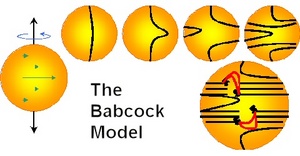
|
| ©Unknown |
Sunspots are cross connected eruptions of the magnetic field lines, shown in red above. Sometimes they break, spewing tremendous amounts of gas and particles into space. Solar flares and coronal mass ejections (CME's) are some examples of this process. Sometimes they snap back like rubber bands. The number of sunspots at solar max is a direct indicator of the activity level of the solar dynamo.
Given the current quietness of the sun and it's magnetic field, combined with the late start to cycle 24 with even possibly a false start, it appears that the sun has slowed it's internal dynamo to a similar level such as was seen during the Dalton Minimum. One of the things about the Dalton Minimum was that it started with a skipped solar cycle, which also coincided with a very long solar cycle 4 from 1784-1799. The longer our current cycle 23 lasts before we see a true ramp up of cycle 24, the greater chance it seems then that cycle 24 will be a low one.
No wonder there is so much talk recently about global cooling. I certainly hope that's wrong, because a Dalton type solar minimum would be very bad for our world economy and agriculture. NASA GISS published a release back in 2003 that agrees with the commonly accepted idea that long period trends in solar activity do affect our climate by changing the Total Solar Irradiance (TSI).
Some say it is no coincidence that 2008 has seen a drop in global temperature as indicated by several respected temperature indexes compared to 2007, and that our sun is also quiet and still not kick starting its internal magentic dynamo.



I've been watching this, too, and have been wondering why there are no sunspots anymore when the sun used to have them all the time.
The American Indians say we're all Related. Maybe the Earth is more Related to the Sun than we realize. If the Earth dies, maybe the sun will follow...